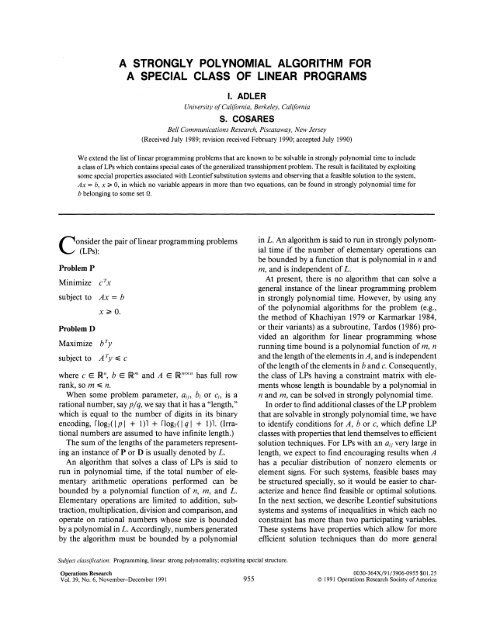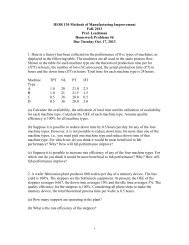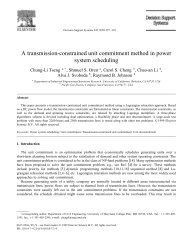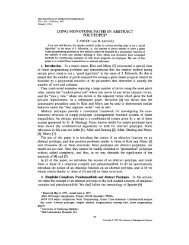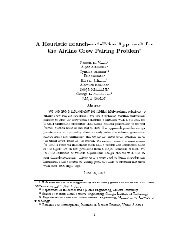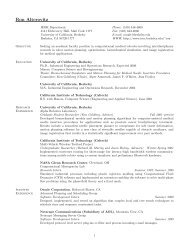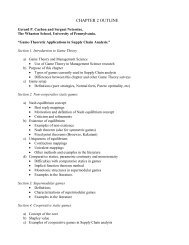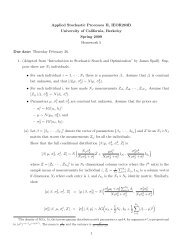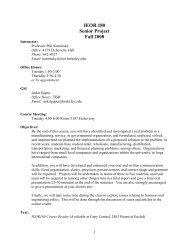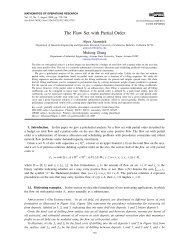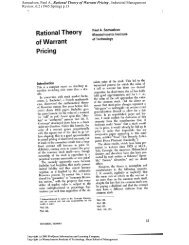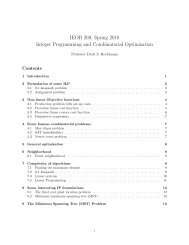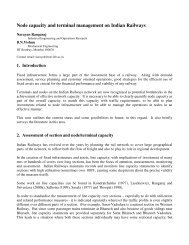a strongly polynomial algorithm for a special class of linear programs
a strongly polynomial algorithm for a special class of linear programs
a strongly polynomial algorithm for a special class of linear programs
Create successful ePaper yourself
Turn your PDF publications into a flip-book with our unique Google optimized e-Paper software.
A STRONGLY POLYNOMIAL ALGORITHM FOR<br />
A SPECIAL CLASS OF LINEAR PROGRAMS<br />
1. ADLER<br />
University <strong>of</strong> Cali<strong>for</strong>nia, Berkeley, Cali<strong>for</strong>nia<br />
S. COSARES<br />
Bell Communications Research, Piscataway, New Jersey<br />
(Received July 1989; revision received February 1990; accepted July 1990)<br />
We extend the list <strong>of</strong> <strong>linear</strong> programming problems that are known to be solvable in <strong>strongly</strong> <strong>polynomial</strong> time to include<br />
a <strong>class</strong> <strong>of</strong> LPs which contains <strong>special</strong> cases <strong>of</strong> the generalized transshipment problem. The result is facilitated by exploiting<br />
some <strong>special</strong> properties associated with Leontief substitution systems and observing that a feasible solution to the system,<br />
Ax = b, x > 0, in which no variable appears in more than two equations, can be found in <strong>strongly</strong> <strong>polynomial</strong> time <strong>for</strong><br />
b belonging to some set Q.<br />
Consider the pair <strong>of</strong> <strong>linear</strong> programming problems<br />
I ~~ (LPs):<br />
Problem P<br />
Minimize c TX<br />
subject to Ax = b<br />
Problem D<br />
x 0.<br />
Maximize b Ty<br />
subject to A Ty < c<br />
where c E R", b E Rm and A E RmXn has full row<br />
rank, so m < n.<br />
When some problem parameter, aij, bi or cj, is a<br />
rational number, say p/q, we say that it has a "length,"<br />
which is equal to the number <strong>of</strong> digits in its binary<br />
encoding, rlog2(I p I+ 1)1 + rlog2( I q I + 1)1. (Irrational<br />
numbers are assumed to have infinite length.)<br />
The sum <strong>of</strong> the lengths <strong>of</strong> the parameters representing<br />
an instance <strong>of</strong> P or D is usually denoted by L.<br />
An <strong>algorithm</strong> that solves a <strong>class</strong> <strong>of</strong> LPs is said to<br />
run in <strong>polynomial</strong> time, if the total number <strong>of</strong> elementary<br />
arithmetic operations per<strong>for</strong>med can be<br />
bounded by a <strong>polynomial</strong> function <strong>of</strong> n, m, and L.<br />
Elementary operations are limited to addition, subtraction,<br />
multiplication, division and comparison, and<br />
operate on rational numbers whose size is bounded<br />
by a <strong>polynomial</strong> in L. Accordingly, numbers generated<br />
by the <strong>algorithm</strong> must be bounded by a <strong>polynomial</strong><br />
in L. An <strong>algorithm</strong> is said to run in <strong>strongly</strong> <strong>polynomial</strong><br />
time if the number <strong>of</strong> elementary operations can<br />
be bounded by a function that is <strong>polynomial</strong> in n and<br />
m, and is independent <strong>of</strong> L.<br />
At present, there is no <strong>algorithm</strong> that can solve a<br />
general instance <strong>of</strong> the <strong>linear</strong> programming problem<br />
in <strong>strongly</strong> <strong>polynomial</strong> time. However, by using any<br />
<strong>of</strong> the <strong>polynomial</strong> <strong>algorithm</strong>s <strong>for</strong> the problem (e.g.,<br />
the method <strong>of</strong> Khachiyan 1979 or Karmarkar 1984,<br />
or their variants) as a subroutine, Tardos (1986) provided<br />
an <strong>algorithm</strong> <strong>for</strong> <strong>linear</strong> programming whose<br />
running time bound is a <strong>polynomial</strong> function <strong>of</strong> m, n<br />
and the length <strong>of</strong> the elements in A, and is independent<br />
<strong>of</strong> the length <strong>of</strong> the elements in b and c. Consequently,<br />
the <strong>class</strong> <strong>of</strong> LPs having a constraint matrix with elements<br />
whose length is boundable by a <strong>polynomial</strong> in<br />
n and m, can be solved in <strong>strongly</strong> <strong>polynomial</strong> time.<br />
In order to find additional <strong>class</strong>es <strong>of</strong> the LP problem<br />
that are solvable in <strong>strongly</strong> <strong>polynomial</strong> time, we have<br />
to identify conditions <strong>for</strong> A, b or c, which define LP<br />
<strong>class</strong>es with properties that lend themselves to efficient<br />
solution techniques. For LPs with an aij very large in<br />
length, we expect to find encouraging results when A<br />
has a peculiar distribution <strong>of</strong> nonzero elements or<br />
element signs. For such systems, feasible bases may<br />
be structured <strong>special</strong>ly, so it would be easier to characterize<br />
and hence find feasible or optimal solutions.<br />
In the next section, we describe Leontief subsitutions<br />
systems and systems <strong>of</strong> inequalities in which each no<br />
constraint has more than two participating variables.<br />
These systems have properties which allow <strong>for</strong> more<br />
efficient solution techniques than do more general<br />
Subject <strong>class</strong>ification. Programming, <strong>linear</strong>: strong polynomality; exploiting <strong>special</strong> structure.<br />
Operations Research 0030-364X/91/3906-0955 $01.25<br />
Vol. 39, No. 6, November-December 1991 955 ?01991 Operations Research Society <strong>of</strong> America
956 / ADLER AND COSARES<br />
systems. We also describe the (generalized) transshipment<br />
problem, which is related to these systems.<br />
Megiddo (1983) presented a <strong>strongly</strong> <strong>polynomial</strong><br />
<strong>algorithm</strong> which finds a feasible solution to inequality<br />
systems in which each no constraint has more than<br />
two participating variables. In Section 2, we show how<br />
the <strong>algorithm</strong> can be used to find a feasible solution<br />
to a related system, Ax = b, x : 0, in which no variable<br />
appears in more than two equations in <strong>strongly</strong><br />
<strong>polynomial</strong> time <strong>for</strong> b belonging to some set Q. In<br />
Section 3, we show that if the system is also a pre-<br />
Leontief substitution system, then an optimal solution<br />
to any LP having the system as a constraint set (and<br />
its dual) can be found in <strong>strongly</strong> <strong>polynomial</strong> time.<br />
Thus, we extend the list <strong>of</strong> LP <strong>class</strong>es that are known<br />
to be solvable by a <strong>strongly</strong> <strong>polynomial</strong> <strong>algorithm</strong>.<br />
1. PRELIMINARIES<br />
1.1. Notation<br />
Let A.. denote the jth column <strong>of</strong> A and Ai* denote the<br />
ith row <strong>of</strong> A. For a set S C {1... n , A*s is defined to<br />
be the submatrix <strong>of</strong> A consisting only <strong>of</strong> those columns<br />
with an index in S. Similarly, AR* is defined to be the<br />
submatrix consisting only <strong>of</strong> those rows with indices<br />
in R C {1. . . m[. For a (column) vector, v, we let VR<br />
denote the vector consisting <strong>of</strong> the elements with<br />
indices in R.<br />
A set <strong>of</strong> m <strong>linear</strong>ly independent columns <strong>of</strong> A is<br />
called a basis. If A*S is a basis, we say that it is feasible<br />
<strong>for</strong> the system in P if the unique (basic) solution to<br />
the system, A*SxS = b, is such that xs 2 0 (i.e., if<br />
A*S b is nonnegative). The basis A*s is feasible<br />
<strong>for</strong> the system in D if the unique solution, ys E R'm,<br />
to YTA*s = cs is such that ys A*j < cj <strong>for</strong> all j 4 S.<br />
We say that a system <strong>of</strong> <strong>linear</strong> constraints has a<br />
maximal solution if there exists a finite feasible solution,<br />
y*, such that y* : ' <strong>for</strong> any feasible solution D.<br />
Similarly, the system has a minimal solution if there<br />
exists a finite feasible, y*, such that y* < ' <strong>for</strong> any<br />
feasible j. Obviously, a maximal (minimal) solution<br />
is optimal <strong>for</strong> a maximization (minimization) LP<br />
problem with a nonnegative objective function, if such<br />
a solution exists.<br />
1.2. Leontief Substitution Systems<br />
If a matrix A has no more that one positive element<br />
in any column it is called a pre-Leontief matrix. The<br />
system Ax = b, x 2 0 is called a pre-Leontief substitution<br />
system (PLSS) if A is pre-Leontief and b is a<br />
nonnegative vector. A is called a Leontief matrix if<br />
there exists at least one solution to the PLSS, whenever<br />
b is strictly positive. The system is called a Leontief<br />
substitution system (LSS) if A is Leontief and b is<br />
strictly positive.<br />
The relationship between pre-Leontief and Leontief<br />
substitution systems is described by the following<br />
result due to Veinott (1968).<br />
Proposition 1. If Ax = b, x , 0 is a PLSS, with at<br />
least one feasible solution, then A and b can be partitioned<br />
after suitably permuting rows and columns to<br />
take the <strong>for</strong>m:<br />
(<br />
A 3A)(i )7 I(b _) xl , X2 _ 0<br />
where<br />
i. A' is a Leontief matrix, and<br />
ii. x is basic feasible solution to A 'x' = b', xl I 0 if<br />
and only if (xl, 0) is a basic feasible solution to<br />
Ax = b, x : 0.<br />
Leontief substitution systems and their feasible bases<br />
are discussed in detail by Veinott (1968) and Koehler,<br />
Whinston and Wright (1975). LSS have many properties<br />
not found in more general systems, so they are<br />
worthy <strong>of</strong> <strong>special</strong> consideration. For instance, every<br />
feasible basis <strong>for</strong> an LSS has a nonnegative inverse<br />
(Dantzig 1955), so the system has a feasible solution<br />
<strong>for</strong> any nonnegative right-hand side. The following<br />
property <strong>of</strong> Leontief matrices also serves to be particularly<br />
useful.<br />
Proposition 2. If A is a Leontief matrix, then the<br />
system A Ty < c, has a finite maximal solution <strong>for</strong> all<br />
c <strong>for</strong> which the system is feasible. Furthermore, the<br />
system A T y : c, has a finite minimal solution <strong>for</strong> all<br />
c<strong>for</strong> which the system is feasible.<br />
A pro<strong>of</strong> <strong>of</strong> this result is presented by Cottle and<br />
Veinott (1972), who characterize polyhedral sets<br />
defined by inequality systems with maximal (minimal)<br />
solutions.<br />
1.3. Constraint Systems With Two Variables<br />
Per Inequality<br />
Consider cases <strong>of</strong> P and D in which every column in<br />
matrix A contains no more than two nonzero elements.<br />
We may chose to representhe structure <strong>of</strong> the<br />
constraint matrix by way <strong>of</strong> an undirected graph with<br />
n edges, corresponding to the columns <strong>of</strong> A.<br />
If the kth column has nonzero elements in rows i<br />
and j, then edge ek in the graph links nodes i and j<br />
(i.e., ek = {i, j4). If the column has only one nonzero<br />
element located in row j, then ek links node j to a root
A StronglyPolynomialAlgorithm ForLPs / 957<br />
node 0. A path <strong>of</strong> length K from node i to node]j is a<br />
sequence <strong>of</strong> adjacent edges <strong>of</strong> the <strong>for</strong>m {{i, hil,<br />
{hi, h2l, . . ., I hK- II A}.<br />
Shostak (1981) describes a methodology by which<br />
the graph structure may be used to obtain a feasible<br />
solution to D (i.e., where the inequalities are <strong>of</strong><br />
the <strong>for</strong>m, ayj + byi < c). Suppose that the system<br />
contains the pair <strong>of</strong> constraints, aiyi + ajyj < cl and<br />
bkyk - bjYj < c2, where both aj and bj are strictly<br />
positive. A nonnegative <strong>linear</strong> combination <strong>of</strong> these<br />
constraints impliesAthe (redundant) constraint,<br />
(bjai) yi + (ajbk) Yk < (bjcI + ajc2),<br />
which also involves no more than two variables.<br />
(Either <strong>of</strong> ai or bk may be 0.)<br />
Generating a new constraint by combining a pair <strong>of</strong><br />
constraints in this way is called per<strong>for</strong>ming an admissible<br />
aggregation. Notice that the admissible aggregation<br />
above involves a pair <strong>of</strong> constraints which<br />
corresponds to adjacent edges, {i, jI and {j, k , in the<br />
graph representing A. We define an admissible path<br />
to be a sequence <strong>of</strong> admissible aggregations <strong>of</strong> a set <strong>of</strong><br />
constraints which corresponds to a path in the graph.<br />
(It should be made clear that not every adjacent pair<br />
<strong>of</strong> edges in the graph corresponds to an admissible<br />
aggregation because the signs <strong>of</strong> the coefficients<br />
involved must be appropriate.)<br />
Combining constraints along an admissible path<br />
from node i to node j determines a constraint involving<br />
only variables yi and yj. Thus, an admissible path<br />
from node i to node 0 or from node i to itself determines<br />
a constraint involving only yi, revealing either<br />
an implicit upper bound or an implicit lower bound<br />
to the variable yj.<br />
We define y3ax and y"'i to be, respectively, the<br />
tightest upper bound and lower bound to yk obtainable<br />
from admissible paths in the graph. If no such upper<br />
(lower) bound exists, then y'ax (ykinl) is set to infinity<br />
(negative infinity).<br />
From an adaptation <strong>of</strong> a theorem by Shostak (1981)<br />
we find the following proposition.<br />
Proposition 3. The system A Ty < c is feasible if and<br />
only ifymax > y in <strong>for</strong> all i. Furthermore, if the system<br />
is feasible, then ymax and yi"' are, respectively, the<br />
largest and smallest values y, can take in any feasible<br />
solution to the system.<br />
Aspvall and Shiloach (1980) present an <strong>algorithm</strong><br />
which finds ykax and ykfi <strong>for</strong> all k in O(m3n L) time.<br />
The authors also describe a routine which finds a<br />
feasible solution to the system within the same time<br />
bound. Megiddo (1983) uses a technique, which we<br />
call "parameterized searching," to improve the running<br />
time bound on the <strong>algorithm</strong> to O(m3n log n)<br />
time (i.e., <strong>strongly</strong> <strong>polynomial</strong> time).<br />
1.4. The (Generalized) Transshipment Problem<br />
Let G = IN, El be a directed graph with node<br />
set, N = 1O, 1, . . ., m 1, and edge set,<br />
E= {ek= (i, j) Ik l.n 1.<br />
The "flow" into edge ek = (i, j) is defined to be a<br />
number assigned to the edge, which represents the<br />
amount <strong>of</strong> some commodity sent from node i to node<br />
j. Associated with each edge is a positive "flow multiplier,"<br />
dk. If the flow assigned to ek is xk, then dkxk<br />
units are received at node j.<br />
The vector b E R'm represents the total demand <strong>for</strong><br />
the commodity at each <strong>of</strong> nodes 1 . . . m (the negative<br />
demand at node i corresponds to a "supply" that must<br />
be depleted). The quantity Ck represents the cost<br />
incurred <strong>for</strong> each unit <strong>of</strong> flow assigned to edge ek. The<br />
generalized transshipment problem, (GTP) is defined<br />
to be the task <strong>of</strong> finding an assignment <strong>of</strong> flow to the<br />
edges which satisfies the demand at nodes 1 ... m at<br />
minimum total cost. The ordinary transshipment<br />
problem (TP) is the <strong>special</strong> case <strong>of</strong> GTP where each<br />
<strong>of</strong> the flow multipliers is unity.<br />
A commonly used LP <strong>for</strong>mulation <strong>for</strong> the GTP is<br />
as follows.<br />
Problem GTP<br />
n<br />
Minimize E CkXk<br />
k=1<br />
subject to E dkxk - Xk = b<br />
k:ek= *,j)<br />
k: ek (j,*)<br />
Xk > 0<br />
which has, as its dual:<br />
Problem DGTP<br />
Maximize<br />
m<br />
biyi<br />
j= 1 .m<br />
subjectto yj-yi
958 / ADLER AND COSARES<br />
to this node is set to 0.) This allows our discussion to<br />
be applicable to the ordinary TP case, where the<br />
constraint would be redundant. Notice that GTP and<br />
DTP can be represented as cases <strong>of</strong> P and D, respectively,<br />
in which the constraint matrix A has no more<br />
than two nonzero elements in any <strong>of</strong> its columns and<br />
both A and -A are pre-Leontief.<br />
Since it is possible <strong>for</strong> an edge multiplier to have a<br />
length, which is not boundable by a <strong>polynomial</strong> in n<br />
and m, an arbitrary instance <strong>of</strong> GTP is not guaranteed<br />
to be solvable in <strong>strongly</strong> <strong>polynomial</strong> time by any <strong>of</strong><br />
the <strong>algorithm</strong>s described earlier.<br />
It turns out, though, that efficient <strong>algorithm</strong>s exist<br />
<strong>for</strong> some <strong>special</strong> cases <strong>of</strong> GTP. Goldberg, Plotkin and<br />
Tardos (1988) provide the first <strong>polynomial</strong> <strong>algorithm</strong>s<br />
<strong>for</strong> the capacitated case which are combinatorial in<br />
nature (i.e., not based on an interior point or ellipsoid<br />
method). Charnes and Raike (1966) present a onepass<br />
method which solves GTP when b > 0 and<br />
c 3 0 and the network either has no directed cycles or<br />
no edges with a flow multiplier greater than one. In<br />
such cases, the feasible bases <strong>for</strong> P, if any exist, have<br />
a structure which makes the problem solvable in<br />
O(m 2) time by a variant <strong>of</strong> Dijkstra's (1959) method.<br />
The authors also show that if A, without the columns<br />
corresponding to the edges incident to node 0, is row<br />
rank deficient, then there exist positive diagonal scaling<br />
matrices, R and C (<strong>of</strong> appropriate dimension),<br />
such that RAC is the node-arc incidence matrix <strong>of</strong> an<br />
ordinary network. Glover and Klingman (1973) give<br />
an efficient method <strong>for</strong> finding R and C, if they exist.<br />
This case is then solvable in <strong>strongly</strong> <strong>polynomial</strong> time,<br />
<strong>for</strong> any values <strong>of</strong> b or c by the method <strong>of</strong> Tardos<br />
(1985).<br />
2. STRONGLY POLYNOMIAL ALGORITHMS<br />
2.1. A Feasibility Problem<br />
Consider instances <strong>of</strong> P and D, where matrix A has<br />
no more than two nonzero elements in any column.<br />
Recall that y7max and y7mif are, respectively, the largest<br />
and smallest values yi can take in any feasible solution<br />
to the system in D. Let<br />
I+= i E- {l. . m} I Iyim'x < 0oo<br />
I- = {i E- {I. .. m}I I ymln > _-oo<br />
Q = {w E- Rm I wi> 0 implies i E I',<br />
wi < 0 implies i E I-}.<br />
Lemma 1. A feasible solution to the system in P, where<br />
b E Q can be found in O(m3n log n) time.<br />
Pro<strong>of</strong>. y?"ax can be interpreted as the optimal objective<br />
value <strong>for</strong> D when b = ei, the ith column <strong>of</strong> an m x m<br />
identity matrix. Similarly, yTfl can be interpreted as<br />
the optimal objective value <strong>for</strong> D when b = -ei. From<br />
duality theory, we know that if yiax is finite, then the<br />
system, Ax = ei, x > 0, has a feasible solution and if<br />
yT"l is finite, then the system, Ax = -ei, x , 0, has a<br />
feasible solution.<br />
For i E II, the constraint yi < yXa, is obtained by<br />
taking a nonnegative <strong>linear</strong> combination <strong>of</strong> a set <strong>of</strong><br />
constraints in the system in D that corresponds to<br />
an admissible path in the graph representing A. Let<br />
x4 E R' be the vector whose components are these<br />
nonnegative multipliers. Similarly, <strong>for</strong> i E I-, let<br />
Xi E- R' the vector <strong>of</strong> nonnegative multipliers used to<br />
generate the bound, Yi yifl* I<br />
It is easy to verify that, Ax' = ei, xJ > 0 and<br />
Ax_ = -ei, x_ , 0. For any b in Q, a feasible solution<br />
to the system in P, xk, is obtained as<br />
x= max(bi, 0) x x+ + E max(-bi, 0) x x-.<br />
iEi+ i+I<br />
By proper "bookkeeping" in the <strong>algorithm</strong> <strong>of</strong><br />
Megiddo (1983), it is possible to find the set <strong>of</strong> constraints<br />
that determine each <strong>of</strong> y7max and yimi and the<br />
associated nonnegative multipliers which determine<br />
these bounds. All <strong>of</strong> this can be accomplished in<br />
O(m3n log n) time.<br />
2.2 A Special Class <strong>of</strong> LPs<br />
Consider instances <strong>of</strong> P and D, where A is pre-Leontief<br />
and has no more than two nonzero elements in any<br />
column, and b is nonnegative. (Note: certain cases <strong>of</strong><br />
GTP and DGTP can be cast as problems in this <strong>class</strong>.)<br />
Lemma 2. Suppose that the system in D is feasible. If<br />
yinax is finite <strong>for</strong> i E M1 and infinite <strong>for</strong> i E M2, then<br />
P has a feasible solution if and only if bi = 0 <strong>for</strong><br />
all i E M2.<br />
Pro<strong>of</strong>. If bi = 0 <strong>for</strong> all i E M2, then XiEM, biy Tax is an<br />
upper bound to the optimal objective function value<br />
<strong>of</strong> D. Since D is feasible and bounded, P must also be<br />
feasible.<br />
If, on the other hand, P is feasible, with bi > 0 <strong>for</strong><br />
some i E M2, then Ai* must be one <strong>of</strong> the rows in the<br />
Leontief submatrix <strong>of</strong> A, described in Proposition 1.<br />
Because the feasible bases <strong>of</strong> LSS have nonnegative<br />
inverses, it follows that the system, Ax = ei, x > 0, has<br />
a feasible solution, say x. By weak duality, c t<br />
provides a finite upper bound to the optimal objective<br />
<strong>of</strong>:
Maximize yi<br />
subjecto A Ty < C<br />
which contradicts that y Tax is infinite.<br />
Permute the rows and columns <strong>of</strong> A so that<br />
A =AMN,1 AmN2 AI A2)<br />
0 AM2N2J 0 A3J<br />
From the pro<strong>of</strong> <strong>of</strong> the lemma, if P is feasible, then<br />
A1 is a Leontief submatrix <strong>of</strong> A. So the system,<br />
A [TYM, CN, has a finite maximal solution, ymax. Since<br />
bM, is nonnegative and bM2 = 0, we can conclude that<br />
the vector y* = (YM,x, YM2) is an optimal solution to<br />
D, where DM2 satisfies<br />
A3 YM2 C2 - A2 M<br />
(Note that the existence <strong>of</strong> a feasible solution to this<br />
system is assured because <strong>for</strong> each i E M2, y7 ax iS<br />
infinite, hence, larger than y7 in. It could be found in<br />
O(m2n) time (Aspvall and Shiloach).<br />
From duality theory and Proposition 1, if y* is an<br />
optimal solution to D, then an optimal solution to P<br />
is x* = (xs, 0), which can be obtained by finding a<br />
feasible solution to the system<br />
AM,SXS = bM, xs _ 0<br />
where S = {j E N1 I (A Ty*)j = cj}. Since y Tax is finite<br />
<strong>for</strong> all i E M1, this can be accomplished by the<br />
methodology described in the previous section. Thus,<br />
we have proved the following theorem.<br />
Theorem 1. IfA is a pre-Leontief matrix with no more<br />
than two nonzero elements in any column, then optimal<br />
solutions to P and D, where b > 0, if they exist,<br />
can befound in O(m3n log n) time.<br />
Corollary. Any instance <strong>of</strong> GTP with either b < 0 or<br />
b > 0 can be solved in <strong>strongly</strong> <strong>polynomial</strong> time.<br />
(Note that <strong>for</strong> GTP, the statements made above apply<br />
to the case where b < 0, because <strong>for</strong> GTP -Ax = -b,<br />
x > 0 is also a pre-Leontief substitution system.)<br />
3. REMARKS<br />
After having found efficient solution techniques <strong>for</strong><br />
LPs with a constraint set which comprises an LSS<br />
whose variables appear in no more than two constraints,<br />
we are curious as to whether there are other<br />
<strong>class</strong>es <strong>of</strong> LPs with Leontief constraint matrices <strong>for</strong><br />
which an efficient <strong>algorithm</strong> can be found. It seems<br />
that the <strong>special</strong> properties associated with these prob-<br />
A StronglyPolynomialAlgorithm For LPs / 959<br />
lems can be exploited to allow <strong>for</strong> a <strong>strongly</strong> <strong>polynomial</strong><br />
<strong>algorithm</strong> <strong>for</strong> a more general <strong>class</strong> <strong>of</strong> problems,<br />
particularly since there is a characterization <strong>of</strong> feasible<br />
bases which is not dependent on the particular values<br />
<strong>of</strong> the numbers in the constraint matrix.<br />
Jeroslow et al. ( 1989) describe properties associated<br />
with a <strong>class</strong> <strong>of</strong> LSS, which are called "gainfree." By<br />
exploiting some hypergraph representation <strong>of</strong> the system,<br />
they have shown that the <strong>class</strong> <strong>of</strong> LPs with a<br />
gainfree Leontief constraint matrix can be solved in<br />
<strong>strongly</strong> <strong>polynomial</strong> time. They also show that since<br />
primal feasible bases <strong>for</strong> these LPs are triangular,<br />
instances with an integral constraint matrix and<br />
rational right-hand side are totally dual integral.<br />
The notion <strong>of</strong> parameterized searching, which was<br />
originally introduced by Megiddo (1979), has proven<br />
to be a very useful tool <strong>for</strong> <strong>algorithm</strong>ic development.<br />
Per<strong>for</strong>ming a parameterized search, in place <strong>of</strong>, say, a<br />
series <strong>of</strong> binary searches not only helps in improving<br />
the running time <strong>of</strong> existing <strong>algorithm</strong>s, but has led<br />
the way <strong>for</strong> the development <strong>of</strong> new efficient <strong>algorithm</strong>s.<br />
Adler and Cosares (1989) describe a "nested"<br />
version <strong>of</strong> the technique which has led the way <strong>for</strong> the<br />
solution <strong>of</strong> additional <strong>class</strong>es <strong>of</strong> the LP problem in<br />
<strong>strongly</strong> <strong>polynomial</strong> time.<br />
ACKNOWLEDGMENT<br />
This research was partially funded by the United States<br />
Office <strong>of</strong> Naval Research under contract N000 14-87-<br />
K-0202. Their support is gratefully acknowledged.<br />
The authors also wish to thank the anonymous<br />
referees <strong>for</strong> their helpful comments.<br />
REFERENCES<br />
ADLER, I., AND S. COSARES. 1989. Nested Parameterized<br />
Searching and a Class <strong>of</strong> Strongly Polynomially Solvable<br />
Linear Programs. Working Paper, University<br />
<strong>of</strong> Cali<strong>for</strong>nia, Berkeley.<br />
ASPVALL, B., AND Y. SHILOACH. 1980. A Polynomial<br />
Time Algorithm <strong>for</strong> Solving Systems <strong>of</strong> Linear<br />
Inequalities With Two Variables Per Inequality.<br />
SIAMJ. Comput. 9, 827-845.<br />
CHARNES, A., AND W. M. RAIKE. 1966. One-Pass Algorithms<br />
<strong>for</strong> Some Generalized Network Problems.<br />
Opns. Res. 14, 914-924.<br />
COTTLE, R. W., AND A. F. VEINOTT, JR. 1972. Polyhedral<br />
Sets Having a Least Element. Math. Prog. 3,<br />
238-249.<br />
DANTZIG, G. B., 1955. Optimal Solution <strong>of</strong> a Dynamic<br />
Leontief Model With Substitution. Econometrica 23,<br />
295-302.<br />
DIJKSTRA, E. W. 1959. A Note On Two Problems in<br />
Connexion With Graphs. Numer. Math. 1, 269-271.
960 / ADLER AND COSARES<br />
GLOVER, F., AND D. KLINGMAN. 1973. On the Equivalence<br />
<strong>of</strong> Some Generalized Network Problems to<br />
Pure Network Problems. Math. Prog. 4, 269-278.<br />
GOLDBERG, A. V., S. A. PLOTKIN AND E. TARDOS. 1988.<br />
Combinatorial Algorithms <strong>for</strong> the Generalized Circulation<br />
Problem. Manuscript MIT/LCS/TM-358,<br />
Laboratory <strong>for</strong> Computer Science, Massachusetts<br />
Institute <strong>of</strong> Technology, Cambridge.<br />
JEROSLOW, R. G., R. K. MARTIN, R. L. RARDIN AND<br />
J. WANG. 1989. Gainfree Leontief Flow Problems.<br />
Working Paper, Graduate School <strong>of</strong> Business,<br />
University <strong>of</strong> Chicago.<br />
KARMARKAR, N. 1984. A New Polynomial-Time Algorithm<br />
<strong>for</strong> Linear Programming. Combinatorica 4,<br />
373-395.<br />
KHACHIYAN, L. G., 1979. A Polynomial Algorithm<br />
in Linear Programming, Soviet Math. Dokl. 20,<br />
191-194.<br />
KOEHLER, G. J., A. B. WHINSTON AND G. P. WRIGHT.<br />
1975. Optimization Over Leontief Substitution<br />
Systems. North-Holland, Amsterdam.<br />
MEGIDDO, N. 1979. Combinatorial Optimization With<br />
Rational Objective Functions. Math. Opns. Res. 4,<br />
414-424.<br />
MEGIDDO, N. 1983. Toward a Genuinely Polynomial<br />
Algorithm <strong>for</strong> Linear Programming. SIAM J.<br />
Comput. 12, 347-353.<br />
SHOSTAK, R. 1981. Deciding Linear Inequalities by Computing<br />
Loop Residues. J. ACM 28, 769-779.<br />
TARDOS, E. 1985. A Strongly Polynomial Minimum Cost<br />
Circulation Algorithm. Combinatorica 5, 247-255.<br />
TARDOS, E. 1986. A Strongly Polynomial Algorithm to<br />
Solve Combinatorial Linear Programs. Opns. Res.<br />
34, 250-256.<br />
VEINOTT, A. F. 1968. Extreme Points <strong>of</strong> Leontief Substitution<br />
Systems. Linear Alg. Its Appl. 1, 181-194.


